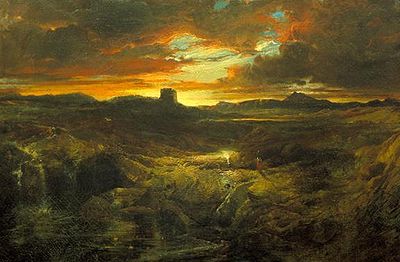- Childe Roland to the Dark Tower Came
-
"Childe Roland to the Dark Tower Came" is a poem by English author Robert Browning, written in 1855 and first published that same year in the collection entitled Men and Women.[1] The title, which forms the last words of the poem, is a line from William Shakespeare's play King Lear. In the play, Gloucester's son, Edgar, lends credence to his disguise as Tom o' Bedlam by talking nonsense, of which this is a part:
Child Rowland to the dark tower came,
His word was still 'Fie, foh, and fum
I smell the blood of a British man.
King Lear, Act 3, scene 4Shakespeare took inspiration from the fairy tale "Childe Rowland", although the poem has no direct connection to the tale. Browning claimed that the poem came to him, fully formed, in a dream.
Browning explores Roland's journey to the Dark Tower in 34 six line stanzas with the rhyme form A-B-B-A-A-B and iambic pentameter. It is filled with images from nightmare but the setting is given unusual reality by much fuller descriptions of the landscape than was normal for Browning at any other time in his career. In general, however, the work is one of Browning's most complex works. This is, in part, because the hero's story is glimpsed slowly around the edges; it is subsidiary to the creation of an impression of the hero's mental state.
The name Roland, references to his slughorn (a pseudo-medieval instrument which only ever existed in the mind of Thomas Chatterton and Browning himself), general medieval setting and the title childe (a medieval term not for a child but for an untested knight) suggest that the protagonist is the paladin of The Song of Roland, the 11th century anonymous French chanson de geste, among other works.
The poem opens with Roland's speculations about the truthfulness of the man who gives him directions to the Dark Tower. Browning does not retell the Song of Roland; his starting point is Shakespeare. The gloomy, cynical Roland seeks the tower and undergoes various hardships on the way, although most of the obstacles arise from his own imagination. The poem ends abruptly when he reaches the tower, so what he finds there is never revealed. In this case it is more important to travel than to arrive.
Judith Weissman has suggested that Browning's aim was to show how the military code of honour and glory "destroys the inner life of the would-be hero, by making us see a world hellishly distorted through Roland's eyes." William Lyon Phelps proposes three different interpretations of the poem: In the first two, the Tower is a symbol of a knightly quest. Success only comes through failure or the end is the realisation of futility. In his third interpretation, the Tower is simply damnation.
For Margaret Atwood, Childe Roland is Browning himself, his quest is to write this poem, and the Dark Tower contains that which Roland/Browning fears most: Roland/Browning "in his poem-writing aspect".[2]
Influences on and references in other works
"Childe Roland" has served as inspiration to a number of popular works of fiction, including:
- American author Stephen King for his The Dark Tower series of stories and novels (1978-2004).
- African-American author Countee Cullen for "From the Dark Tower" poem (1927)
- Welsh science fiction author Alastair Reynolds for the "Diamond Dogs" novella (2001).
- Canadian science-fiction author Gordon R. Dickson for his "Childe Cycle" series of novels (1959-2001).
- American science-fiction author Andre Norton for the fourth novel in her "Witch World" series (1967).
- The 'Doctor Who' Twentieth Anniversary special 'The Five Doctors' takes much imagery and several key phrases from the poem which has been cited as a source by screenwriter Terrance Dicks.
- British novelist A. S. Byatt for the character Roland Michell (and perhaps his formidable love interest Maude Bailey ("bailey"="tower")) in her novel Possession: A Romance (1990).
- 'The Dark Tower', a radio play written by Louis MacNeice with incidental music by Benjamin Britten which was first broadcast in 1946 on the BBC's Home Service (now Radio 4). This play follows the basic theme of the original with references to the quest, the dark tower, and the trumpet.[3]
- Willa Cather's The Burglar's Christmas.
- John Connolly's novel The Book of Lost Things (2006).
- Roger Zelazny's novel Sign of the Unicorn (1975) refers to the song and the poem (part of The Chronicles of Amber series).
- Lawrence Ferlinghetti's poem I Am Waiting refers to Childe Rowland coming 'to the final darkest tower'.
- P.G. Wodehouse's novel The Mating Season: Jeeves uses the phrase 'Childe Roland to the Dark Tower came' to describe Bertie Wooster's arrival at Deverill Hall. Bertie does not understand the reference.[4]
- Neil Gaiman's Sandman character, Charles Rowland, one of the Dead Boy Detectives, is a reference to Childe Roland, particularly in his The Children's Crusade miniseries (1993), which prominently features a dark tower, a motif later picked up by the Books of Magic series.
References
- ^ Although Loucks gives the poem as written already in 1852. Loucks, James F., ed. (1979). Robert Browning’s Poetry: Authoritative Texts Criticism. New York: Norton. p. 139. ISBN 0393090922.
- ^ Atwood, Margaret (2002). Negotiating with the Dead. Cambridge, United Kingdom: Cambridge University Press. p. 33. ISBN 0521662605.
- ^ MacNeice, Louis (1947). The Dark Tower and other radio scripts. London: Faber and Faber Ltd..
- ^ Wodehouse, P.G. (2008). The Mating Season. London: Arrow Books. p. 49. ISBN 9780099513773.
Categories:- Poetry by Robert Browning
- Titles derived from the works of William Shakespeare
- 1855 poems
Wikimedia Foundation. 2010.

